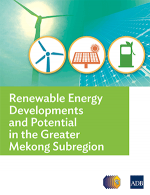Renewable Energy Developments and Potential for the Greater Mekong Subregion

Renewable energy is a challenge, but also an opportunity for new industries, employment, and new ways to reduce dependency on fuel imports, provide electricity to poor remote areas, reduce air pollution, and provide a healthier environment.
Prepared in collaboration with the governments of Cambodia, the Lao PDR, Myanmar, Thailand, and Viet Nam, this report was published with the objective of helping accelerate the development of renewable energy and energy efficiency in the Greater Mekong Subregion (GMS). The report focuses on renewable energy developments and potential in Cambodia, the Lao People’s Democratic Republic, Myanmar, Thailand, and Viet Nam, and assesses the potential of solar, wind, biomass, and biogas as sources of renewable energy.
Technical considerations include the degree and intensity of solar irradiation, average wind speeds, backup capacity of grid systems, availability and quality of agricultural land for biofuel crops, and animal manure concentrations for biogas digester systems. Most GMS governments have established plans for reaching these targets and have implemented policy, regulatory, and program measures to boost solar, wind, biomass, and biogas forms of renewable energy. Incentives for private sector investment in renewable energy are increasingly emphasized.
This report was produced as part of a study conducted under the ADB technical assistance project (TA 7679). The project was cofinanced by the Asian Clean Energy Fund and the Multi-Donor Clean Energy Fund under the Clean Energy Financing Partnership Facility of ADB.
Download |
Renewable Energy Developments and Potential for the Greater Mekong Subregion |
Last Updated: Thursday, 16 July 2015
